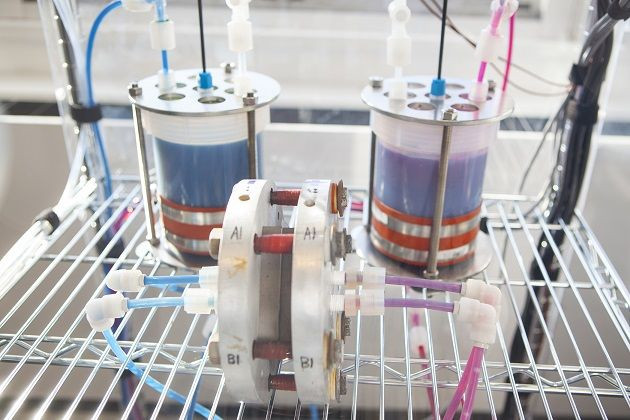New Battery Technology Could Help Unlock Solar, Wind Power Potential

A new kind of battery designed by Harvard University scientists and engineers could unlock the potential of renewable energy sources like wind and solar.
One of the problems with solar and wind power is that the flow of electricity can’t be constant – the sun sets or goes behind clouds, and the wind dies or picks up. This can cause problems if these systems are wired into the electric grid, which has trouble handling sudden massive surges and dips in demand (Hawaii and Germany are two areas where this problem has already begun to butt up against widespread solar panel adoption). Having a reliable, cheaper way of storing massive amounts of electricity would be a big step towards wider reliance on these alternative energy sources.
In a paper published in the journal Nature on Wednesday, Harvard chemist Roy Gordon and colleagues described their design for a special kind of battery that might fit the bill. The team’s current model is just a laboratory experiment for now, but they think it could be scaled up to store large amounts of energy, providing the buffer that the grid needs to handle excess energy pouring in from solar panels and wind turbines. And the central ingredient of the battery is relatively cheap, which means it may move to market quicker.
The team has created a type of flow battery, which stores energy in external tanks filled with chemicals, rather than within the battery itself. Flow batteries have been around for a couple decades, but the active component of current models is the metal vanadium, which is costly – and probably not abundant enough to be the basis of a long-term technological solution.
“The amount of vanadium that’s mined and refined over 1 year is sufficient only to store about an estimated .01 or .02 percent of the electrical energy that we’d like to store to make renewable energy useful,” Gordon said in a phone interview.
Even if we were able to extract all the vanadium that geologists think lies in the Earth’s crust, that would still fall short – bumping up storage to just 1 or 2 percent of the goal, according to Gordon.
The new flow battery design is based around quinones -- not to be confused with quinine, the stuff in tonic water also used to treat malaria -- which are a kind of organic compound found widely in plants and crude oil, and commonly used in dyes and film photography. (The quinone molecule that the Harvard team used is almost identical to one found in rhubarb.) And, the researchers say, it’s already performing on par with a vanadium flow battery – after just a year in development.
The anode, or negative electrode, of the battery is made from a diluted solution of quinones in sulfuric acid. The other end of the battery, the postively-charged cathode, is made from bromine. The anode reacts with positively charged protons to form the higher-energy hydroquinone, charging the battery. The qunione-hydroquinone reaction is about 1,000 times faster than the corresponding vanadium reaction, according to Nature.
The U.S. Department of Energy, which funded the team’s work, thinks that flow batteries would need to cost around $100 per kilowatt-hour to be attractive enough for utility companies to consider. At present, the vanadium component of current flow batteries alone counts for $80 per kWh, according to the MIT Technology Review – which makes it just about impossible for the whole battery meet that cost target. But the Harvard team thinks that a quniones-based flow battery will bring the cost of the energy-storing material is down to just $27 per kWh.
Next, Gordon and colleagues are working on integrating the design into a demonstration model, a horse trailer-sized set up that will be able to store 24 hours of energy from a 3.5 kW solar panel system.
The battery wouldn’t be just for big utility grids. The technology could also be scaled for individual homeowners to use – provided you don’t mind a vat or two of chemicals sitting around.
"Imagine a device the size of a home heating oil tank sitting in your basement,” coauthor Michael Marshak said in a statement. “It would store a day's worth of sunshine from the solar panels on the roof of your house, potentially providing enough to power your household from late afternoon, through the night, into the next morning, without burning any fossil fuels."
SOURCE: Huskinson et al. “A Metal-Free Organic-Inorganic Aqueous Flow Battery.” Nature published 8 January 2014.
© Copyright IBTimes 2024. All rights reserved.





















